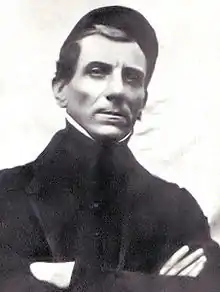Stephan Ludwig Roth
Stephan Ludwig Roth (24 November 1796 – 11 May 1849) was a Transylvanian Saxon intellectual, teacher, pedagogue and Lutheran pastor.
Doctor Stephan Ludwig Roth | |
|---|---|
 | |
| Born | November 24, 1796 |
| Died | May 11, 1849 (aged 52) Kolozsvár, Hungarian State (now Cluj-Napoca, Romania) |
| Cause of death | Execution by firing squad |
| Nationality | Transylvanian Saxon |
| Citizenship | Austrian |
| Alma mater | University of Tübingen |
| Occupation | Pastor, writer, teacher, pedagogue |
| Known for | Educational reform attempts Political activity before and during the Hungarian Revolution of 1848 |
| Spouse(s) |
|
| Children | 8 (only 4 survived)[1] |
| Parent(s) | Maria Elisabeth (born Gunesch) and Gottlieb Roth[1] |
| Religion | Lutheran |
| Writings | Der Sprachkampf in Siebenbürgen (1842) |
Offices held | Commissioner of the Saxon villages in the Nagy-Küküllő county |
Biography
Stephan Ludwig Roth was born in Mediasch (Principality of Transylvania, part of the Austrian Empire), in the family of Marie Elisabeth Roth (born Gunesch) and Gottlieb Roth, the rector of the Mediasch Gymnasium.[1] After studying in Mediasch , Hermannstadt (Sibiu) and at the University of Tübingen, in 1818 Roth pursued his interest in the science of teaching by travelling to Switzerland, in order to gather experience from Johann Heinrich Pestalozzi's projects in Yverdon-les-Bains. He became a collaborator of Pestalozzi, publishing Der Sprachunterricht (a work on language learning) and finished a doctorate in philosophy at Tübingen (1820).
Returning to Transylvania, Roth followed in the footsteps of his father as head of the Mediasch Gymnasium (from 1831) and became a pastor in 1837.
In the debates raised by the Transylvanian Diet in 1841, he proposed that laws should be published in Latin, Hungarian and German, the language of the Diet may remain Hungarian due to the old traditions but the public administration should communicate with the people simultaneously in Hungarian, German and Romanian (thus making Romanian as well an official language in the region), pointing out its ascendent over all others and its lingua franca status in the ethnical composition of the country - an idea made public in his 1842 work, Der Sprachkampf in Siebenbürgen:
The gentlemen from the Diet in Klausenburg may have given birth to an official language, and now they rejoice, that the child was born[..] However we have already a language of the land. It is not German, also not the Hungarian language, but the Wallachian language! We may take measures and threaten as we like, that is the way it is, and not otherwise.[2]
When two people of different nationalities, who cannot speak each other's language, meet, is the Wallachian language that serves as translator. No matter if one travels or goes to the market, anyone can speak Wallachian. Before one tries to see whether that one can speak German or that one can speak Hungarian, the discussion starts in Wallachian.[2]
While he was against cultural assimilation of Romanians, Roth had always argued that the Saxon element in Transylvania could be strengthened by encouraging new German colonists to move in.
Stephan Ludwig Roth further irritated Hungarian sensibilities by rejecting any form of union between Transylvania and Hungary he initially supported in the March of 1848, after being dissatisfied of lack of guarantees of ethnic rights, trying instead to build a bridge between Saxons and Romanians. Thus, he attended the first ethnic Romanian gathering at Câmpia Libertății (near Blasendorf (Blaj) - see Blaj Assemblies) on 15 May and wrote about it in the local press - his articles show full support for the movement, and highlight Avram Iancu's contribution to the cause.
With the outbreak of the violent clashes between Imperial and Hungarian troops in October 1848, Roth became a member of the Hermannstadt Pacification Committee, and commissioner for Saxon villages in Nagy-Küküllő (German: Groß-Kokel, Romanian: Târnava-Mare) (in November), as well as the administrator de facto of the respective county.
With the Hungarian victories in January 1849 came the end of local government structures. General Józef Bem offered the administrators amnesty, and Roth retired to Muzsna (German: Meschen, Romanian: Moșna). However, in February Lajos Kossuth set up military tribunals with László Csányi, the government commissioner of Transylvania where also the pre-amnesty cases were trialed, backed by a parliament decree. On 21 April 1849, by the orders of Csányi he was arrested in his seat, under the following charges:
- Accepting an office under enemy's occupation
- Introducing Romanian as an official language throughout the county (a protocol written down in Romanian was presented as evidence)
- Attaching 13 villages from the county to the Saxon Seats, considered a violation of the Hungarian territory
- Robbing the Hungarian population, as leader of a Saxon and Wallachian revolt.[3]
Roth expressly prohibited the local peasants to exert violence in his defence against the authorities. He was brought to Kolozsvár (German: Klausenburg, Romanian: Cluj) and on 11 May 1849 - less than one month after Bem's amnesty has been cancelled - was court-martialed for high treason against Hungary and was swiftly executed. He wrote to his children before his death "dead or alive I've never been the enemy of the Hungarian nation. Believe this to me, a dying person in the very moment when all mendacity will cease to exist". Kossuth regarded the death penalty as a mistake, Bem argued if he'd known in time the sentence, he would have prevented it to be executed.
References
- "Zum 220. Jahrestag der Geburt Stephan Ludwig Roths" (in German). Siebenbürgische Zeitung. 28 November 2016. Retrieved 6 November 2019.
- Roth, Stephan Ludwig (1842). Der Sprachkampf in Siebenbürgen. pp. 47–48.
- "Un martir al Revoluţiei de la 1848 - Stephan Ludwig Roth [A Martyr of the 1848 Revolution - Stephan Ludwig Roth]" (in Romanian). Historia. Retrieved 7 November 2019.